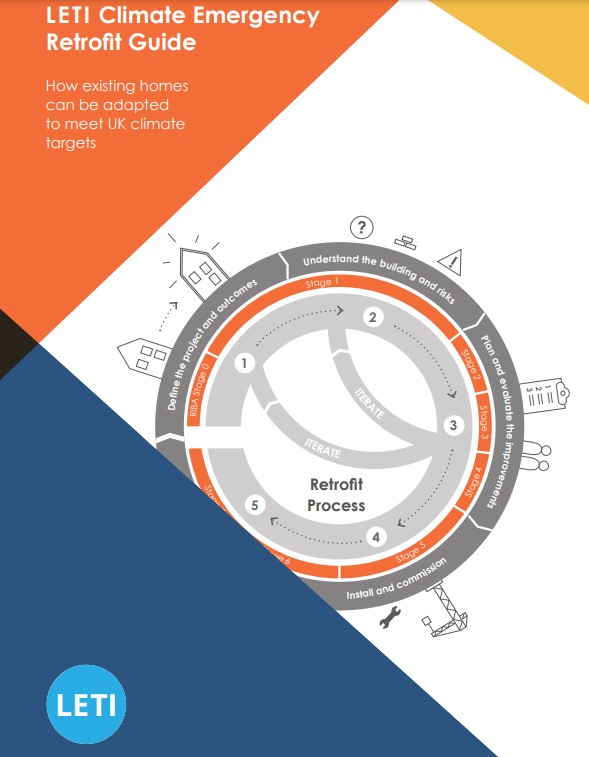LETI publishes Climate Emergency Retrofit Guide

|
In October 2021, more than 100 construction professionals representing leading architecture and engineering firms, academia and NGOs joined together for the publication of the London Energy Transformation Initiative (LETI) Climate Emergency Retrofit Guide, which aims to provide a blueprint for how we can retrofit our homes to support the UK's net zero targets.
The publication provides guidance on how those targets can be achieved through energy efficiency measures and heat pumps. LETI defines retrofit specifications for four primary housing types (mid-terrace, semi-detached, detached and apartment) and provides advice on how to meet those specifications.
It is widely accepted that retrofitting existing buildings is critical for the UK to be zero carbon by 2050. Around 18% of annual national CO2 emissions come from existing homes.
LETI has gathered more than 100 retrofit experts from across the construction industry to agree on how to retrofit existing domestic buildings so that the buildings meet our future needs.
The Climate Emergency Retrofit Guide sets out what good retrofit looks like for existing homes. LETI defines space heating and energy use requirements – targeting a 60% to 80% reduction in total energy consumption for the average UK home. These targets have been determined through a combination of practical experience and understanding of what measures are realistically achievable, informed by a national housing stock model, to examine issues such as renewable energy provision and grid capacity, said LETI.
The guide points out the potential risks of poor retrofit and advises on how to deliver efficient, resilient and healthy homes. LETI stated that good retrofit can bring multiple environment, social and economic benefits but this requires a whole-house approach and a shift from fossil fuels to electricity for heating and hot water.
Antonia Khayatt from LETI said, "Retrofitting buildings to be more energy efficient doesn't just reduce carbon emissions and energy bills. It can improve comfort and health, create jobs and reduce fuel poverty. It can also reduce the demand on and costs to the UK's energy infrastructure. This guide explains these issues and shows how taking the LETI approach to retrofit will help us enjoy these broader benefits."
This publication follows LETI's Climate Emergency Design Guide in 2020, which outlined requirements for new buildings to ensure climate change targets are met.
The cross-industry guide, published by LETI, is backed by professional institutions and organisations including the Royal Institute of British Architects (RIBA), the UK Green Building Council (UKGBC) and the Better Building Partnership (BBP). The guide is available to download for free.
This article originally appeared on the CIAT website under the title, 'LETI publish blueprint for retrofitting UK's homes to meet climate emergency'. It was published on 21 October 2021.
--CIAT
[edit] Related articles on Designing Buildings
Featured articles and news
The UK's Modern Industrial Strategy: A 10 year plan
Previous consultation criticism, current key elements and general support with some persisting reservations.
Building Safety Regulator reforms
New roles, new staff and a new fast track service pave the way for a single construction regulator.
Architectural Technologist CPDs and Communications
CIAT CPD… and how you can do it!
Cooling centres and cool spaces
Managing extreme heat in cities by directing the public to places for heat stress relief and water sources.
Winter gardens: A brief history and warm variations
Extending the season with glass in different forms and terms.
Restoring Great Yarmouth's Winter Gardens
Transforming one of the least sustainable constructions imaginable.
Construction Skills Mission Board launch sector drive
Newly formed government and industry collaboration set strategy for recruiting an additional 100,000 construction workers a year.
New Architects Code comes into effect in September 2025
ARB Architects Code of Conduct and Practice available with ongoing consultation regarding guidance.
Welsh Skills Body (Medr) launches ambitious plan
The new skills body brings together funding and regulation of tertiary education and research for the devolved nation.
Paul Gandy FCIOB announced as next CIOB President
Former Tilbury Douglas CEO takes helm.
UK Infrastructure: A 10 Year Strategy. In brief with reactions
With the National Infrastructure and Service Transformation Authority (NISTA).
Ebenezer Howard: inventor of the garden city. Book review.
The Grenfell Tower fire, eight years on
A time to pause and reflect as Dubai tower block fire reported just before anniversary.
Airtightness Topic Guide BSRIA TG 27/2025
Explaining the basics of airtightness, what it is, why it's important, when it's required and how it's carried out.
Construction contract awards hit lowest point of 2025
Plummeting for second consecutive month, intensifying concerns for housing and infrastructure goals.
Understanding Mental Health in the Built Environment 2025
Examining the state of mental health in construction, shedding light on levels of stress, anxiety and depression.






















